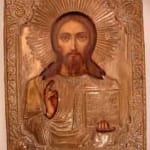Christ Pantocrator, 19th Century CE
Oklad/Oil on Wood
10.5
PF.5735
Inseparable from the liturgical tradition, religious art is seen by Orthodox Christians as a form of pictorial confession of faith and a channel of religious experience. Because the icons provide...
Inseparable from the liturgical tradition, religious art is seen by Orthodox Christians as a form of pictorial confession of faith and a channel of religious experience. Because the icons provide direct personal contact with the holy persons represented on them, these images were objects of veneration, in either a public or private setting, and were even believed to have the ability to heal.
The oil painting of this icon is extremely realistic, unlike most Russian icons that relate to the Byzantine style. However, the head and hands of Christ appear to be influenced more by Northern Renaissance artists such as Jan Van Eyck and Hans Memling. The majority of this extraordinary work is encased in a brass oklad. A repoussee technique in high relief has been utilized to produce the folds and curves of his drapery and the pages and text of the open Bible he holds. An interweaving floral motif decorates the outer border, including a line of Cyrillic text at the bottom center. To represent Christ’s halo, an additional engraved oklad with crystalline-shaped, tiered edges has been attached to the icon. The brass oklad not only imitates the elegance of gold, but also contrasts and emphasizes the softness of the painted flesh. Here, Christ raises his right hand in a sign of benediction while showing us the testament detailing his own divinity and humanity. We can identify with him, seeing his humanity portrayed in his large, sympathetic eyes. Like many icon paintings, this work attempts to combine the familiar and the divine into one. He is mortal, like us; yet holy, worthy of our adoration and veneration.
The oil painting of this icon is extremely realistic, unlike most Russian icons that relate to the Byzantine style. However, the head and hands of Christ appear to be influenced more by Northern Renaissance artists such as Jan Van Eyck and Hans Memling. The majority of this extraordinary work is encased in a brass oklad. A repoussee technique in high relief has been utilized to produce the folds and curves of his drapery and the pages and text of the open Bible he holds. An interweaving floral motif decorates the outer border, including a line of Cyrillic text at the bottom center. To represent Christ’s halo, an additional engraved oklad with crystalline-shaped, tiered edges has been attached to the icon. The brass oklad not only imitates the elegance of gold, but also contrasts and emphasizes the softness of the painted flesh. Here, Christ raises his right hand in a sign of benediction while showing us the testament detailing his own divinity and humanity. We can identify with him, seeing his humanity portrayed in his large, sympathetic eyes. Like many icon paintings, this work attempts to combine the familiar and the divine into one. He is mortal, like us; yet holy, worthy of our adoration and veneration.



